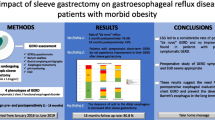Abstract
Purpose
Laparoscopic antireflux surgery (LARS) is a feasible treatment for gastroesophageal reflux disease (GERD) patients, but it is unclear who will benefit from the surgery. This study investigated patients’ GERDspecific quality of life (GsQOL) and analyzed the factors leading to the performance of successful LARS.
Methods
Twenty-six (57.8%) of 45 consecutive patients who underwent LARS for GERD during the last decade were enrolled. All patients were evaluated by 24-h pH monitoring, esophageal manometry, esophagogastro-duodenoscopy and physical examinations. GsQOL was assessed by a visual analog scale, and the difference between the pre- and postoperative scores was defined as the visual analog scale improvement score (VASIS). The patients were classified into three groups based on the VASIS, and their clinical factors and surgical outcomes were compared.
Results
The high VASIS group patients (>70 VASIS; Excellent group) patients were significantly younger and obese in comparison to low the VASIS group (<30 VASIS; Poor group) consisting of older nonobese patients (P < 0.05). A multiple regression analysis revealed that age <60 years and body mass index (BMI) >25 kg/m2 were significant factors that affected postoperative GsQOL. No other clinical or surgical factors had any influence on the postoperative GsQOL.
Conclusion
These results suggest that age and BMI can be predictive factors for the performance of successful LARS.
Similar content being viewed by others
References
Donnellan C, Sharma N, Preston C, Moayyedi P. Medical treatments for the maintenance therapy of reflux oesophagitis and endoscopic negative reflux disease. Cochrane Database Syst Rev 2005:CD003245.
DeVault KR, Castell DO. Updated guidelines for the diagnosis and treatment of gastroesophageal reflux disease. The Practice Parameters Committee of the American College of Gastroenterology. Am J Gastroenterol 1999;94:1434–1442.
Wang W, Huang MT, Wei PL, Lee WJ. Laparoscopic antireflux surgery for the elderly: a surgical and quality-of-life study. Surg Today 2008;38:305–310.
Society of American Gastrointestinal Endoscopic Surgeons (SAGES). Guidelines for surgical treatment of gastroesophageal reflux disease (GERD). Surg Endosc 1998;12:186–188.
Velanovich V. Comparison of generic (SF-36) vs. disease-specific (GERD-HRQL) quality-of-life scales for gastroesophageal reflux disease. J Gastrointest Surg 1998;2:141–145.
Guyatt GH, Townsend M, Berman LB, Keller JL. A comparison of Likert and visual analogue scales for measuring change in function. J Chronic Dis 1987;40:1129–1133.
Granderath FA, Kamolz T, Schweiger UM, Pasiut M, Wykypiel H Jr, Pointner R. Quality of life and symptomatic outcome three to five years after laparoscopic Toupet fundoplication in gastro-esophageal reflux disease patients with impaired esophageal motility. Am J Surg 2002;183:110–106.
Gee DW, Andreoli MT, Rattner DW. Measuring the effectiveness of laparoscopic antireflux surgery: long-term results. Arch Surg 2008;143:482–487.
Oelschlager BK, Quiroga E, Parra JD, Cahill M, Polissar N, Pellegrini CA. Long-term outcomes after laparoscopic antireflux surgery. Am J Gastroenterol 2008;103:280–287; quiz 288.
Nocon M, Labenz J, Jaspersen D, Meyer-Sabellek W, Stolte M, Lind T, et al. Association of body mass index with heartburn, regurgitation and esophagitis: results of the Progression of Gastroesophageal Reflux Disease study. J Gastroenterol Hepatol 2007;22:1728–1731.
de Vries DR, van Herwaarden MA, Smout AJ, Samsom M. Gastroesophageal pressure gradients in gastroesophageal reflux disease: relations with hiatal hernia, body mass index, and esophageal acid exposure. Am J Gastroenterol 2008;103:1349–1354.
Choi CW, Kim GH, Song CS, Wang SG, Lee BJ, I H, et al. Is obesity associated with gastropharyngeal reflux disease? World J Gastroenterol 2008;14:265–271.
El-Serag HB, Graham DY, Satia JA, Rabeneck L. Obesity is an independent risk factor for GERD symptoms and erosive esophagitis. Am J Gastroenterol 2005;100:1243–1250.
Lee J, Anggiansah A, Anggiansah R, Young A, Wong T, Fox M. Effects of age on the gastroesophageal junction, esophageal motility, and reflux disease. Clin Gastroenterol Hepatol 2007;5:1392–1398.
Achem AC, Achem SR, Stark ME, DeVault KR. Failure of esophageal peristalsis in older patients: association with esophageal acid exposure. Am J Gastroenterol 2003;98:35–39.
McDougall NI, Johnston BT, Collins JS, McFarland RJ, Love AH. Three- to 4.5-year prospective study of prognostic indicators in gastro-oesophageal reflux disease. Scand J Gastroenterol 1998;33:1016–1022.
Jackson PG, Gleiber MA, Askari R, Evans SR. Predictors of outcome in 100 consecutive laparoscopic antireflux procedures. Am J Surg 2001;181:231–235.
Wiener GJ, Richter JE, Copper JB, Wu WC, Castell DO. The symptom index: a clinically important parameter of ambulatory 24-hour esophageal pH monitoring. Am J Gastroenterol 1988;83:358–361.
Katz PO, Dalton CB, Richter JE, Wu WC, Castell DO. Esophageal testing of patients with noncardiac chest pain or dysphagia. Results of three years’ experience with 1161 patients. Ann Intern Med 1987;106:593–597.
Okamoto K, Iwakiri R, Mori M, Hara M, Oda K, Danjo A, et al. Clinical symptoms in endoscopic reflux esophagitis: evaluation in 8031 adult subjects. Dig Dis Sci 2003;48:2237–2241.
Thibault R, Coron E, Sebille V, Sacher-Huvelin S, Bruley des Varannes S, Gournay J, et al. Antireflux surgery for non-erosive and erosive reflux disease in community practice. Aliment Pharmacol Ther 2006;24:621–632.
Bytzer P. Assessment of reflux symptom severity: Methodological options and their attributes. Gut 2004;53Suppl 4:iv28–iv34.
Sharma P, Wani S, Romero Y, Johnson D, Hamilton F. Racial and geographic issues in gastroesophageal reflux disease. Am J Gastroenterol 2008;103:2669–2680.
Granderath FA, Kamoltz T, Schweiger UM, Pasiut M, Haas CF, Wykypiel H, et al. Long-term results of antireflux surgery. Surg Endosc 2002;16:753–757.
Author information
Authors and Affiliations
Rights and permissions
About this article
Cite this article
Irino, T., Takeuchi, H., Ozawa, S. et al. Age and body mass index: significant predictive factors for successful laparoscopic antireflux surgery. Surg Today 40, 1137–1143 (2010). https://doi.org/10.1007/s00595-009-4200-9
Received:
Accepted:
Published:
Issue Date:
DOI: https://doi.org/10.1007/s00595-009-4200-9




